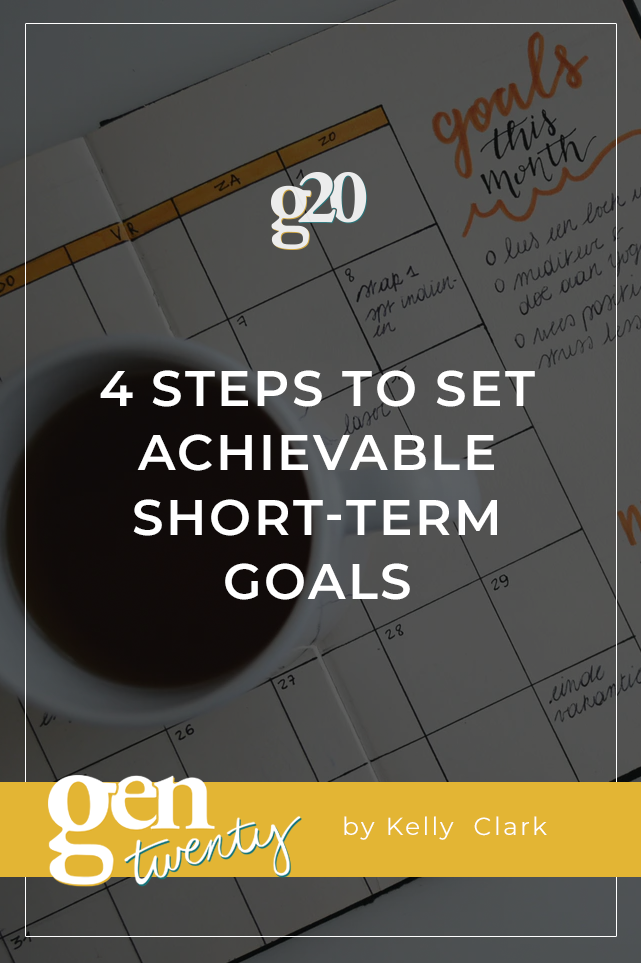
Goal setting may seem like a straightforward process, but there are many different strategies and systems, all stating that they are the ultimate goal-setting method.
This makes it hard to know which one is correct! Ultimately you need to find what works best for you. Do we go big by setting lofty dream-like goals that we hope to achieve, or do we stay small, focusing on one aspect at a time? In my experience, I have found the most success with my goals by doing both. I like to think of it as a backward goal-setting. I start with a big goal, then break it down until I can’t break it down anymore. I’ve broken it down to 4 manageable steps to set achievable short-term goals.
Short-term goal setting helps us with productivity and you can break them down with these 4 steps:
I believe that we don’t partake in goal-setting just for the fun of it. Although, if you are like me, you can geek out on all things productivity and goal setting.
We set goals because we are passionate about becoming our best selves. We know that there is more inside us and we want to let that out. This isn’t a bad thing but can turn toxic if you let it overtake you.
Because of this, it is important to stay mindful about why you choose the goals you do, and what is your attitude/emotion toward yourself saying towards you. If you begin to see that your motivation towards achieving this goal is not healthy, it’s probably best that you choose a different goal. On the other hand, if you truly believe that achieving this goal will add value to your life and you have a healthy mindset about it, then you should go for it.
1. Start with an intention/big goal for the year.
This can be anything from a word of the year to a single goal that you want to focus on. During this first step, you can start vague. However, before you move on to the next step you’ll want to spend time transitioning them to SMART goals.
If you aren’t sure what SMART goals are or need a refresher, SMART goals stand for Specific, Measurable, Achievable, Relevant, Time-bound. Basically SMART goals transform “I want to lose weight” to “I will lose 30 pounds by the end of the year by eating a fruit or vegetable with every meal and working out five to six days a week.” Do you see how much more thought-out and actionable the second goal is?
2. Break it down to monthly goals.
Next, It’s time to break the big goal down to monthly goals. You’ll want these to be SMART goals as well. To start, ask yourself, “What actions can I do each month that will add up to me meeting my goal?” I like to have monthly focuses, but setting the same goal every month works too.
I’ve found that monthly focuses work best for complex goals like starting a business or developing a healthier lifestyle. Let’s use the example of starting a business/side-hustle. In your first month, you may want to dedicate yourself to doing market research or creating a business plan. The next month your focus can be developing your mission statement and brand, etc..
Once you have those focuses determined, you can turn them into SMART goals. Your goal can be that you will have a complete business plan finalized by the end of the month. What will some of your monthly focus goals be?
3. Determine what you need to do each week to meet your monthly goals.
Now that you know your monthly goals, the next step is to determine your weekly goals. If we are continuing with the previous example, a goal here would be to complete a section of the business plan each week.
By breaking it into these weekly short-term goals it makes it easier, and more approachable, to achieve those bigger goals. Otherwise, you won’t have much direction on how to achieve the goal. You run the risk of leaving it until the end of the month or giving up in the middle of the month.
4. Find daily tasks that line up with your goals
You’ve made it to the final step! It’s time to take those weekly short-term goals and turn them into daily tasks. When you craft your to-do list around your goals, you will be more motivated to achieve your goals. At least that is what I’ve experienced. Spending time each day on your goals makes it that much easier to achieve them.
This can be done in many ways. You could reserve a certain task for a specific task, like researching Mondays. You could also set a daily power hour to work towards your goal. This would be beneficial if you are having trouble making time to work on these tasks.
There you have it—my preferred way to set short-term goals for myself so I can achieve even bigger ones. I’ll admit that this format may not work for every type of goal. However, it definitely helps make big, complex goals feel more easily achievable. This then frees you to truly dream/goal-set without the fear of those being too big and unrealistic.
Next time you are having trouble figuring out the right moves to make to reach your goals, try working backward. You may just find that this was the goal-setting method you needed all along.
